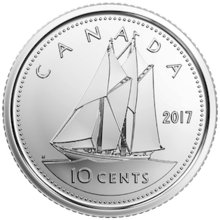Canada | |
| Value | 0.10 Canadian dollar |
|---|---|
| Mass | 1.75 g |
| Diameter | 18.03 mm |
| Thickness | 1.22 mm |
| Edge | Milled |
| Composition | Nickel-plated steel 92% steel, 5.5% Cu, 2.5% Ni plating |
| Years of minting | 1858–present |
| Catalog number | – |
| Obverse | |
 | |
| Design | Elizabeth II, Queen of Canada |
| Designer | Susanna Blunt |
| Design date | 2003 |
| Design discontinued | 2023 |
| Design | Charles III, King of Canada |
| Designer | Steven Rosati |
| Design date | 2023 |
| Reverse | |
 | |
| Design | Bluenose schooner |
| Designer | Emanuel Hahn; design based on photographs of the Bluenose[1] |
| Design date | 1937 |
In Canada, a dime is a coin worth ten cents. It has been the physically smallest Canadian coin since 1922; it is smaller even than the country's penny, despite its higher face value. According to the Royal Canadian Mint, the official national term of the coin is the 10-cent piece, but in practice, the term dime predominates in English-speaking Canada. It is nearly identical in size to the American dime. Unlike its American counterpart, the Canadian dime is magnetic due to a distinct metal composition. From 1968 to 2000, it was composed entirely of nickel, and since 2001, it has consisted of a steel core with plating composed of layers of nickel and copper.
The most prevalent version of the coin features a portrait of Elizabeth II on the obverse, although a new version featuring Charles III was introduced in 2023. The reverse contains a representation of the Bluenose, a famous Canadian schooner. According to the Royal Canadian Mint, "Artist Emanuel Hahn developed his design for the 10-cent coin from photos of the famous Bluenose schooner."[1] The coin is produced by the Royal Canadian Mint at its facility in Winnipeg.
The word dime comes from the French word dîme, meaning "tithe" or "tenth part", from the Latin decima [pars].
- ^ a b "Pride and skill–the 10-cent coin". mint.ca. Royal Canadian Mint. Archived from the original on January 15, 2021. Retrieved March 30, 2020.